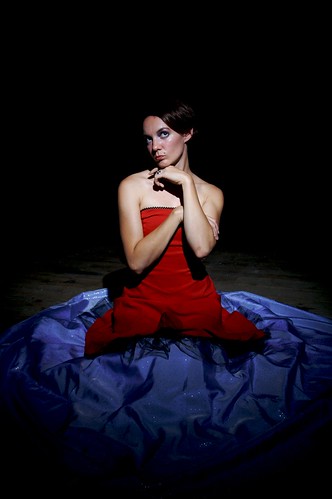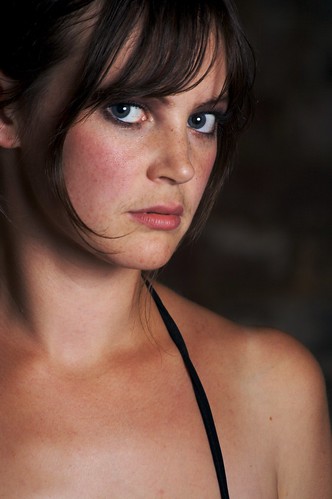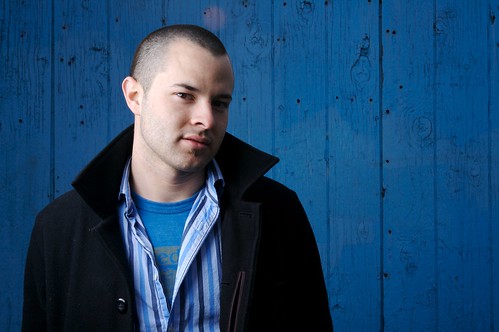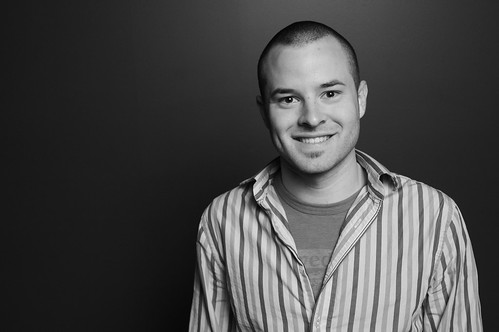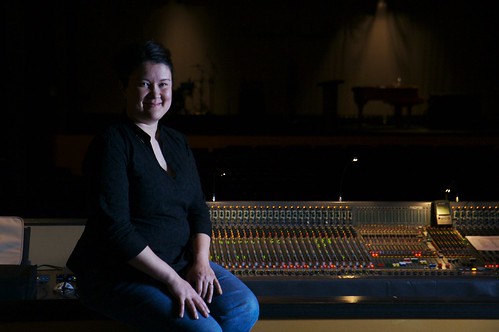A good way to learn something is to to hear multiple people give their views. Recently both David Hobby (the Strobist) and Zack Arias (Mr. OneLight) have written posts on the use of umbrellas with off camera lights.
Tag Archives: strobist
Return of Guinea Pig TV…
Long time readers will know that my girls embarked on a series of videos starring their guinea pig, Chatterboy. Julie facilitated this by getting the girls a blog for Guinea Pig TV. For a variety of reasons, Guinea Pig TV has been on hiatus, until a few days ago when the crew put up a new episode, inspired by the Seattle Flickrites’ escapades with Chase Jarvis.
Seattle photography scene
The Seattle amateur photography scene is exploding. Here’s some video that shows what we’ve been up to recently.
My favorite picture from the event:
Maybe now David Hobby will move to Seattle…
Seattle Flickr sociality
Recently I’ve been doing some photo stuff with some folks from the Seattle Flickr Meetup group, particularly a bunch of people that are interested in Strobist style off camera lighting. Being able to interact with a community of similarly interested people has been a huge help to me. David Hobby’s post yesterday was about helping connect people to others in their locales who are also interested in lighting. As a bonus, he links to some video of our latest escapade. Here are a few of my shots from that same event.
[This is my first post using MarsEdit 2.0, which has great Flickr support built in]
Revamped OneLight Workshop site
Seattle Strobist Seminar, August 2007
I spent yesterday over in Seatac at the first of David Hobby’s two Seattle Strobist seminars. I had pretty high expectations for this, because David has set such a high standard on his blog. I also was hoping that David would go at fast pace, but I was prepared for the fact that he might need to slow down enough to keep the material accessible for those just getting started. I was definitely not disappointed on either count. The format of the day is pretty simple. Introductions and a chance for David to find out if people have particular interests, some lecture on theory, and then watching David set up a shoot of a hypothetical important person, using whatever room he’s been given.
There are so many different kinds of content at a seminar like this. There’s the straight “theory content”, which in this case was a fleshing out of the 7 Light Controls that David outlined at the beginning of Lighting 102 David’s style is really interactive, so as he walked us through each of the controls, there were digressions, questions from the participants and demonstrations. \
Another type of content is watching someone put that content into practice. I’ve always found that I learn something by watching someone else shoot. With someone like David, that experience is multiplied because you see how the theory he’s been discussing gets translated in to actual practice. Of course, you can take the theory and other content from David’s site and do that (and a *lot* of people are, as the Strobist Flickr pool will attest), but there are a lot of nuances that you just have to see in order to pick up. A number of other attendees said this to me in asides as we were watching. For the shoot of the important person, David’s goal was to do 4-5 completely different looks, using the exactly same room. You can see exemplars of the various looks in David’s Flickr stream (this is the first). If you look, you’ll see that they are completely different from each other. We saw gelling walls to different colors, making a wall of any color go to white (or black), making a highly reflective surface (projector screen) into a “blowaway” white background, turning a stack of drinking glasses into an abstract background, and more. In addition to the lighting aspects, I also found it instructive to see how David directed a subject’s posing and how he interacted with a subject to build a rapport.
The last kind of content is the hallway track content, which broke down two ways. One reason that I signed up for the seminar, was that I wanted to meet other people local to Seattle who were motivated enough about lighting to put down some money, in the hopes of finding some folks to shoot/talk with. That definitely happened, and there’ll be more on that in another post. The other part of the hallway track was the chance to hang out with David (and a bunch of other people) in the hotel bar after the official time was over. David is as personable and funny in person as he is on the site, and we had a great time with everything from full vs partial RSS feeds, how Knottyy has gone from 0-100 on landscape shooting, to the history of the Seattle underground, to way over my head stuff having to do with LAB color in Photoshop. It was totally a blast.
(ironic for the Strobist to get shot with an on camera pop-up flash – but it was late)
Here are some of my personal takeaways:
- I need to expand my imagination – That’s what is limiting the kinds of shot I want to do, or am willing to try
- I need to just experiment and not be afraid to burn frames – David’s style is very organic and exploratory. You have to be willing to try things and see if they will work. The drinking glass background was a great example of this. Ironically, I seem to need to learn this lesson over and over. Even though the “freeness” of digital frames was what got me back into photography, I realized that I have not been as willing to experiment as I probably should be
- I have more backgrounds than I think I do – Another thing that has been holding me back from shooting more at home (with my abundant supply of models) is feeling like I don’t have any good clean backgrounds to work with. Yesterday’s shoot pretty much demolished that idea.
- 1/4 CTO gels are my friend – I’ve done just about nothing with gels. Well except for the gel that I somehow melted. David is gelling just about all the time.
- Set up thoroughly so you can get people in and out and not burn up your “rapport time” – I’ve actually had some recent experience with this, but hearing David talk about various shoots that he’s done really drove this point home.
- I need to build some grids and gobos. I built a set of the cereal box snoots, and I’ve used them for a few shots, but I don’t like the rectangular shape of the light, so I’ve laid off of them. But I knew after the OneLight that I really like grids, and seeing David’s grids just pushed me over the edge.
- Cross light, cross light, cross light – I have learned to think in terms of balancing lights, but I haven’t really internalized looking for cross lighting situations.
Strobist vs OneLight
At the moment, I am probably the only person in the world who has attended both Zack Aria’s OneLight workshop and David Hobby’s Strobist Seminar, so a comparison is inevitable. Heck, David was asking me about it in the bar.
The OneLight is a completely self contained workshop. Zack does not assume that you have any prior experience with off camera lighting, which makes the OneLight perfect if workshops are a good learning style for you. You can start from nothing and get the basics all in one day. One major advantage of the OneLight is that after a full day of lecture and theory, you spend another 4-5 hours doing hands on shooting. Zack gets a model, and he and the workshop participants walk the model around and shoot using the stuff that you learned. Zack is right there to look at your images, give you feedback or help, and he swears not to go home until all your questions are answered. And he means it. Zack’s background is a music photographer, so you are also get his view of the photography world. I personally found that to be refreshing and interesting. Zack also had a different take on equipment, which I found interesting. In particular, I never would have found out about the awesome Westcott Apollo series of umbrella mount softboxes if it hadn’t been for the OneLight.
The Strobist Seminar is a slightly different animal because it also has the Strobist blog, and the enormous Strobist community around it. That means that David can leverage those things to make the seminar work well, both before (he asked some of the novices to at least read through Lighting 101), and after (you know there will be massive Flickr threads) the event. You will definitely get more out of the seminar if you have at least looked through the site. The one thing that David doesn’t do is take you shooting and help you out and give you feedback. Many of my fellow attendees expressed a desire to do that. Doing two seminars back to back makes that a tough proposition for David, and it would raise the cost because of the need to hire a model.
In the end, I spent the money for both workshops, and I’m not sorry about either one. When I took the OneLight, I had done David’s lighting bootcamp, but I still found that I learned things, and the experience of watching/shooting with someone experienced was well worth it. I would say that the Strobist workshop is stronger on the theory, and that the only real lack is the shooting part. I’d jump at the chance to participate in a David mentored DINFOS type shoot. In the end, I don’t think you can really go wrong with either one. It’s probably more a question of getting to one in your area. I was super fortunate that both of these came to Seattle this year. As photo workshops go, they are both pretty inexpensive – both of these dudes could be charging more. In fact, I mentioned this to David yesterday, and he told me that he didn’t feel it was in keeping with the spirit of the site to charge more, and he assured me that eating was not going to be a problem for him any time soon. I love a man who can live by his principles.
Update: I forgot to mention that there are a few setup photos in my Flickr stream…
Congratulations to the Strobist, Again!
David Hobby, the author of the Strobist blog, is taking a leave of absence from his “professional” job in order to spend more time with his family, and try to make the most of the opportunities presented to him by the amazing uptake of Strobist. I am glad to see that he’s worked out an arrangement that lets him see if Strobist has wings. I, and many others have learned a huge amount from David, and I am sure that this will be an exciting year for him (and us, by extension).
If you aren’t following the Lighting 102 series, you really owe it to yourself to do so. In the second unit, David filled in the one area that Zack Arias’s OneLight workshop didn’t cover that well, the impact of flash to subject distance. As always, no only did David show how it worked, but he explained it way better than just regurgitating the inverse square law: “Light has depth of field.” Great explanation.
I haven’t shot the assignments yet, having been on an “off the grid” vacation for a week (and now trying to dig out after that), but I am anxious to do so. We shot a variation of the first assignment on angle, at the OneLight, so I don’t feel quite so behind. Here’s one of the OneLight angle shots:
Strobist Lighting 102
It looks like David Hobby over at Strobist is going to run a new version of last year’s summer long lighting workshop. I learned a ton of stuff from the bootcamp last year, and after the OneLight Workshop, I am highly motivated to do a bunch more lighting stuff. If you are interested in improving the quality of your pictures via off camera lighting, you owe it to yourself to participate in Lighting 102.
Seattle One Light Workshop
Yesterday I took a day off from work and attended Zack Arias‘ One Light Workshop. The One Light covers how to use a single off camera light to enhance your photographs. I found out about it when some pictures from the One Light Workshop Alumni Pool showed up in the Strobist Flickr Pool. Since I had participated in David Hobby’s Strobist Boot Camp last year, I had some idea about many of the concepts that Zack taught during the One Light, but it was very valuable to me to see how someone like Zack put those techniques to work, and to be able ask questions and clarify my understanding. One big revelation was how Flash to Subject distance and the Inverse Square Law affect lighting. There are still a few pieces of that which are fuzzy, and I’m going to have to do some more reading to feel comfortable with the theory, but Zack gave some really compelling and practical applications of the theory to real world shooting situations.
One of the best parts of the workshop is that Zack gets a model and we all went on a photoshoot, and watched Zack put the theory into practice. Then we all got to try our hand at it, and get help from Zack while everything was still going on. I’m usually a learn it from a book (or blog) kind of guy, but I definitely found the hands on aspects of the workshop to be the most helpful. We did a number of things that really helped me *see* how light was behaving.
The other great benefit of the One Light was the chance to meet other photographers in the Seattle area. I got to meet Erin Vey, who has been doing wonderful work on Flickr for quite some time. The Rodriguez brothers, Gabriel and Boone worked hard to put the One Light together and were great hosts in addition to being good photographers. We had a good sized contingent of people from Vancouver B.C., and it sounded like they were going to get their own One Light sometime soon. It was interesting for me to hear the professional photographers talking about their business and to get a glimpse into life in the photography world. Zack had a lot of good information about how he’s built up his photography business
Here are a few of the images that I made during the workshop:
I need to do more with black and white, so here’s a try at that.
I’m particularly happy with this shot. The One Light was held at Mars Hill Church in Seattle, and this was taken in their main auditorium, which has a big sound booth right smack in the middle. There’s a SunPak 120j with a 10 degree grid lighting up Theresa’s face, and the ambient light (sound board, and stage in the far background) is getting picked up by a slow shutter. We did this one during our “go shoot something time”, and I came up with the concept for this, so it felt good to go from concept to actual image.
If you have the opportunity to go to a One Light, I would highly recommend it. Zack has the same low budget approach that David Hobby is taking over at Strobist, and Zack is travelling a lot more than David is (David, if you do a workshop in the Pacific Northwest, I am there). Also the One Light is pretty inexpensive compared to most photo workshops and if you have a day job, it happens all in one day (there’s a mixer the night before).
Update: More Images
Congrats to Strobist!
It’s the Strobist blog’s first birthday! Congratulations to the awesome David Hobby, and my thanks for completely changing my understanding of flash photography and lighting.

